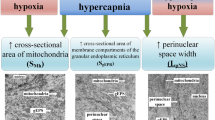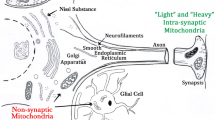Abstract
Previous studies have shown that hypoxia results in a modification of the binding characteristics of the neuronal nuclear membrane inositol tetrakisphosphate (IP4) and inositol triphosphate (IP3) receptors. The present study tests the hypothesis that hypoxia-induced modification of the IP4 and IP3 receptors results in increased IP4 and IP3 dependent Ca2+ influx in neuronal nuclei as a function of the degree of cerebral tissue hypoxia in newborn piglets. Studies were performed in piglets, 3–5 days old, divided into normoxic (N = 5) and hypoxic (N = 6) groups. The hypoxic group was exposed to decreased Fio2 ranging from 0.15 to 0.05 for 1 h. Brain tissue hypoxia was documented biochemically by determining ATP and phosphocreatine (PCr) levels. Neuronal nuclei were isolated and 45Ca2+ influx was determined in a medium containing 50 mM Tris buffer (pH 7.4), neuronal nuclei (150 μg protein), 1 μM 45Ca2+, with or without 10 μM IP4 or IP3. In normoxic and hypoxic groups, ATP levels were 4.27 ± 0.80 and 1.40 ± 0.69 μmoles/g brain, respectively, P < .001 (ranging from 4.78 to 0.82). PCr levels were 3.40 ± 0.99 and 0.91 ± 0.57 μmoles/g brain, respectively, P < .001 (raning from 4.07 to 0.60). During hypoxia, IP4-dependent intranuclear 45Ca2+ influx increased from 3.39 ± 0.64 in normoxic nuclei to 13.30 ± 2.18 pM/mg protein in hypoxic nuclei (P < .01). There was an inverse correlation between the 45Ca2+ influx in neuronal nuclei and the levels of cerebral tissue ATP (r = 0.83) and PCr (r = 0.85). Similarly, IP3-dependent intranuclear 45Ca2+ influx increased from 2.26 ± 0.38 pmoles/mg protein in normoxic nuclei to 11.12 ± 1.65 pmoles/mg protein in hypoxic nuclei and showed an inverse correlation between 45Ca2+ influx in neuronal nuclei and the levels of cerebral tissue ATP (r = 0.86) and PCr (r = 0.71). The data demonstrate that there is an IP4- as well as IP3-dependent increase in nuclear Ca2+ influx with increasing cerebral tissue hypoxia, suggesting a hypoxia-induced modification of the nuclear membrane IP4 and IP3 receptors. We propose that there is a specific level of tissue hypoxia that results in a critical increase of intranuclear Ca2+ that leads to altered transcription of apoptotic genes and activation of nuclear endonucleases resulting in hypoxia-induced programmed neuronal death.
Similar content being viewed by others
references
Ghosh A. and Greenberg M. E. 1995. Calcium signaling in neurons: Molecular mechanisms and cellular consequences. Science 268:239–247.
Bito, H., Deisseroth, K., and Tsien, R. W. 1997. Ca2+-dependent regulation in neuronal gene expression. Curr. Opin. Neurobiol. 7:419–429.
Hardigham, G. E. and Bading, H. 1998. Nuclear calcium: A key regulator of gene expression. Biometals 11:345–358.
Chawla, S. and Bading H. 2001. CREB/CBP and SRE-interacting transcriptional regulators are fast on-off switches: Duration of calcium transients specifies the magnitude of transcriptional responses. J. Neurochem. 79:849–858.
Fields, R. D., Esthete, F., Stevens, B., and Itoh, K. 1997. Action potential-dependent regulation of gene expression: Temporal specificity in calcium cyclic AMP-responsice element binding proteins, and mitogen-activated protein kinase signaling. J. Neurosci. 17:7252–7266.
Lerea, L. S., Butler, L. S., and McNamar, J. O. 1992. NMDA and non-NMDA receptor-mediated increase of c-fosmRNA in dentate gyrus neurons involved calcium influx via different routes. J. Neurosci. 12:2973–2981.
Bading, H., Ginty, D. D., and Greenberg M. E. 1993. Regulation of gene expression in hippocampal neurons by distinct calcium signaling pathways. Science 260:181–186.
Lerea, L. S. and McNamara, J. O. 1993. Ionotropic glutamate receptor subtypes activate c-fos transcription by distinct calcium requiring intracellular signaling pathways. Neuron 10:31–41.
Hardigham, G. E., Chawla, S., Johnson, C. M., and Bading H. 1997. Distinct functions of nuclear and cytoplasmic calcium in the control of gene expression. Nature 385:260–265.
Hardigham, G. E., Chawla, S., Cruzalegui, F. H. and Bading H. 1999. Control of recruitment and transcription activating function of CBP determined gene regulation by NMDA receptor and L-type calcium channels. Neuron 22:789–798.
Dolmetsch, R. E., Pajvani, U., Fife, K., Spotts, J. M., and Greenberg, M. E. 2001. Signaling to the nucleus by an L-type calcium channel-calmodulin complex through the MAP kinase pathway. Science 294:333–339.
Dolmetsch, R. E., Lewis, R. S., Goodnow, C. C. and Healy, J. I. 1997. Differential activation of transcrition factors induced Ca2+ response amplitude and duration. Nature 386:855–858.
Mishra, O. P. and Delivoria-Papadopoulos, M. 1992. NMDA receptor modification of the fetal guina pig brain during hypoxia. Neurochem Res. 17:1211–1216.
Hoffman, D. J., DiGiacomo, J. E., Marro, P. J., Mishra, O. P., and Delivoria-Papadopoulos, M. 1994. Hypoxia-induced modification of the N-methyl-D-aspartate (NMDA) receptor in the brain of newborn piglets. Neurosci. Lett. 167:156–160.
Fritz, K. I., Groenendaal, F., McGowan, J. E., Mishra, O. P., and Delivoria-Papadopoulos, M. 1996. Effects of 3-(2-carboxy-piperzine-4-yl)-propy-1-phosphonic acid (CPP) on NMDA receptor binding characteristics and brain cell membrane function during cerebral hypoxia in newborn piglets. Brain Res. 729:66–74.
Zanelli, S. A., Numagami, Y., McGowan, J. E., Mishra, O. P., and Delivoria-Papadopoulos, M. 1999. NMDA receptor mediated Calcium influx in cerebral cortical synaptosomes of the hypoxic guinea pig fetus. Neurochem. Res. 24:437–446.
Mishra, O. P. and Delivoria-Papadopoulos, M. 2002. Nitric oxide mediated Ca2+-influx in neuronal nuclei and cortical synaptosomes of normoxic and hypoxic newborn piglets. Neurosci. Lett. 318:93–97.
Giuffrida, A. M., Cox, D., and Mathias, A. P. 1975. RNA polymerase activity invarious classes of nuclei from different regions of rat brain during postnatal development. J. Neurochem. 24:749–755.
Lowry, O. H., Rosenbrough, N. J., Farr, A. L., and Randal, R. J. 1951. Protein measurement with the Folin phenol reagent. J. Biol. Chem. 193:265–275.
Lamprechet, W., Stein, P., Heinz, F., and Weissner, H. 1974. Creatine phosphate. Pages 177–1781, in Bergmeyer, H. U. (ed.), Methods of Enzymatic Analysis, Vol. 4, Academic Press, New York.
Mishra, O. P. and Delivoria-Papadopoulos, M. 1999. Cellular mechanisms of hypoxic injury in the developing brain. Brain Res. Bull. 48:233–238.
Frandsen, A. and Schousboe, A. 1991. Dantrolene prevents cytotoxicity and Ca2+ release from intrcellular stores in cultured cerebral cortial neurons. J. Neurchem. 56:1075–1078.
Mishra, O. P., Zanelli, S. A., Ohnishi, S. T., and Delivoria-Papadopoulos, M. 2000. Hypoxia-induced generation of nitric oxide free radicals in cerebral cortex of newborn guinea pigs. Neurochem Res. 25:1559–1565.
Zubrow, A. B., Delivoria-Papadopoulos, M., Ashraf. Q. M., Fritz, K. I., and Mishra, O. P., 2002. Nitric oxide-mediated Ca2+/calmodulin-dependent protein kinase IV activity during hypoxia in neuronal nuclei from newborn piglets. Neurosci. Lett. 335:5–8.
Zubrow, A. B., Delivoria-Papadopoulos, M., Ashraf, Q. M., Ballesteros, J. R., Fritz, K. I., and Mishra, O. P. 2002. Nitric oxide-mediated expression of Bax protein and DNA fragmentation during hypoxia in neuronal nuclei from newborn piglets. Brain Res. 954:60–67.
Mishra, O. P., Ashraf. <given-name>Q. M., and Delivoria-Papadopoulos, M. 2002. Phosphorylation of cAMP response element binding (CREB) protein during hypoxia in cerebral cortex of newborn piglets and the effect of nitric oxide synthase inhibition. Neurosci. 115:985–991.
Al-Mohanna, F. A., Caddy, K. W. T., and Boisover, S. R., 1994. The nucleus is insulated from large cytosolic calcium ion changes. Nature 367:745–750.
Humbert, J.-P., Matter, N., Artault, J.-C., Koppler, P., and Malviya, A. N., 1996. Inositol 1,4,5,-triphosphate receptor is located to the inner nuclear membrane vindicating regulation of nuclear calcium signaling by inositol 1,4,5-triphosphate. J. Biol. Chem. 271:478–485.
Qayyum, I., Georgiadis, P., Kubin, J., Mishra, O. P. and Delivoria-Papadopoulos, M. 2000. Effect of nitric oxide synthase (NOS) inhibition on inositol 1,4,5 triphosphate receptor in neuronal nuclei of newborn piglets. Pediatr. Res. 464A.
Huang, Z., Huang, P. L., Panathian, N., Dalkara, T., Fishman, M. C., and Moskowitz, M. A. 1994. Effects of cerebral ischemi-ain mice deficient in neuronal nitric oxide synthase. Science 265:1183–1885.
Yun, H.-Y., Dawson, V. L., and Dawson, T. M. 1997. Nitric oxide in health and diseases of the nervous system. Mol. Psychiatr. 2:300–310.
Numagami, Y., Zubrow, A. B., Mishra, O. P., and Delivoria-Papadopoulos, M. 1997. Lipid free radical generation and brain cell membrane alteration following nitric oxide synthase inhibition during cerebral hypoxia in the newborn piglet. J. Neurochem. 69:1542–1547.
Zanelli, S. A., Ashraf, Q. M., and Mishra, O. P. 2002. Nitration is a mechanism of regulation of the NMDA receptor function during hypoxia. Neuroscience 112:869–877.
Author information
Authors and Affiliations
Corresponding author
Rights and permissions
About this article
Cite this article
Mishra, O.P., Delivoria-Papadopoulos, M. Inositol Tetrakisphosphate (IP4)- and Inositol Triphosphate (IP3)-Dependent Ca2+ Influx in Cortical Neuronal Nuclei of Newborn Piglets Following Graded Hypoxia. Neurochem Res 29, 391–396 (2004). https://doi.org/10.1023/B:NERE.0000013742.19074.7e
Issue Date:
DOI: https://doi.org/10.1023/B:NERE.0000013742.19074.7e




